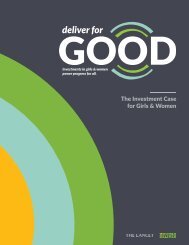Solutions Panorama
A collection of 100 programs, initiatives, and strategies that were shared at the Women Deliver 2016 Conference.
A collection of 100 programs, initiatives, and strategies that were shared at the Women Deliver 2016 Conference.
Create successful ePaper yourself
Turn your PDF publications into a flip-book with our unique Google optimized e-Paper software.
Scaling-Up<br />
Breastfeeding in<br />
Bangladesh<br />
Featuring:<br />
Government of Bangladesh;<br />
Alive and Thrive; BRAC; UNICEF<br />
Where:<br />
Bangladesh<br />
Time Frame:<br />
2009-2016<br />
DESCRIPTION<br />
Breastfeeding is a well-known maternal and neonatal health<br />
practice that powers significant health benefits for women and<br />
babies. Bangladesh is a country that has seen a substantial increase<br />
in breastfeeding rates in recent years (43 percent in 2007 to 64<br />
percent in 2012) – a success that can be largely attributed to a<br />
combination of community mobilization, mass media campaigns and<br />
interpersonal communication around the importance of breastfeeding,<br />
comprehensive health worker training (a vital resource for positive<br />
nutritional education in the country), and the strategic use of data<br />
for advocacy for program design. Additionally, the Government of<br />
Bangladesh has committed to creating an enabling environment for<br />
breastfeeding, for example by instituting a state-allotted 6-month<br />
maternity leave.<br />
Bangladesh has received support from technical experts from the<br />
Alive and Thrive Initiative, BRAC, UNICEF, and civil society, to focus on<br />
reaching scale and addressing known barriers. From 2009 to November<br />
2014, the Alive & Thrive Initiative launched a comprehensive program<br />
in the country to scale-up breastfeeding and complementary feeding<br />
practices and to reduce stunting and young child anemia.<br />
IMPACT<br />
Over the past eight years, exclusive breastfeeding<br />
in Bangladesh has increased by 13 percent.<br />
From 2009-2014, the Alive and Thrive Initiative<br />
contributed to the overall increase through a<br />
range of activities, including but not limited to:<br />
• 1.7 million women, mothers of children under<br />
2, were counseled on infant and young child<br />
feeding by more than 10,000 frontline workers<br />
• Changes in exclusive breastfeeding were<br />
close to 25 percent higher in Alive and Thrive<br />
intervention areas<br />
• Alive & Thrive broadcast seven TV spots<br />
nationwide, and features of the Alive & Thrive<br />
interpersonal and community mobilization<br />
approach were introduced by BRAC in 50<br />
sub-districts and spread to 172 additional subdistricts<br />
through BRAC’s Essential Health Care<br />
Program and Maternal, Neonatal, and Child<br />
Health Program.<br />
LEARN MORE<br />
“Why invest, and what it will take to improve breastfeeding practices?,”<br />
Nigel C Rollins, et al.<br />
Alive and Thrive Iniative in Bangladesh;<br />
aliveandthrive.org<br />
Source: Improve Maternal and Newborn Health and Nutrition policy brief<br />
23<br />
WOMEN DELIVER 2016 CONFERENCE: SOLUTIONS PANORAMA



